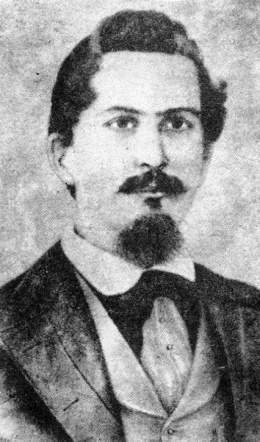Joaquín de Agüero facts for kids
Quick facts for kids
Joaquín de Agüero
|
|
|---|---|
 |
|
| Born | November 15, 1816 |
| Died | August 12, 1851 (aged 34) Puerto Príncipe, Cuba
|
| Nationality | Cuban |
| Occupation | Lawyer |
| Known for | emancipation, liberation |
Joaquín de Agüero was a brave Cuban leader who fought for freedom in the 1800s. He was born in Puerto Príncipe (now Camagüey) on November 15, 1816. He believed everyone should be free. In 1843, he set an example by freeing all the enslaved people on his own land. Later, in 1851, he led a rebellion against the Spanish government in Cuba. Even though his fight was tough, he was captured and sadly died for his beliefs on August 12, 1851. His actions helped inspire future generations to fight for Cuba's independence.
Contents
Early Life and Education
Joaquín de Agüero studied law in Havana, a big city in Cuba. He had to return home when his father became very ill. After his father passed away, Joaquín inherited his land and the enslaved people who worked on it.
He was known for being a very generous person. He even started a free public school for children who didn't have much money. This school was in a small town called Guáimaro. Years later, in 1869, this very school became the place where Cuba's first constitution was written. This constitution was for a free Cuba, showing how important Guáimaro was to the country's history.
Fighting for Freedom
Joaquín de Agüero took a very bold step in 1843. He freed all the enslaved people on his land. He also gave each of them a piece of land so they could support themselves. This action caused a lot of worry among the Spanish rulers and many other plantation owners.
Freeing enslaved people was against the law at that time. To avoid legal trouble, Joaquín had to leave Cuba with his family. They went to the United States. However, he loved his homeland very much and returned to Cuba within three months.
Secret Independence Movements
After returning, Agüero stayed on his farm called "El Redentor," near Guáimaro. He secretly joined groups that wanted Cuba to be free from Spanish rule. By 1849, he became a key figure in a group called "La Sociedad Libertadora de Puerto Príncipe." This group wanted to fight against the Spanish government.
Agüero's group openly spoke out against Spanish rule and demanded independence for Cuba. He led a small force of only forty men. They were quickly defeated by the Spanish troops. Agüero was arrested while trying to escape to the United States. His armed rebellion did not succeed, but it was an important moment. Historian Cento Gomez said it was a "ground breaking event" in Cuba's fight for independence.
Capture and Execution
Because of the strong fight against Spanish rule, Joaquín de Agüero decided to take up arms. He went into the wild, remote areas of Cuba to fight. He gave up his comfortable life to fight against the Spanish colonial government.
He led the "Liberating Society of Port-au-Prince." His group also printed flyers against the colonial government. Even though he brought several rebel groups together, they lacked good organization and military knowledge. This led to their failure in many actions, like trying to capture the city of Las Tunas.
Spanish troops hunted him down intensely. He decided to try and escape to the United States again. However, he was betrayed, captured, and tortured on his way back to Puerto Príncipe. He was sentenced to death. On August 12, 1851, he was shot by a firing squad. Three of his friends were also shot with him. This happened in a place called Sabana de Méndez, which is now a plaza named after him in Camagüey.
A Lasting Legacy
After Joaquín de Agüero's death, the city of Port-au-Prince (Camagüey) went into deep mourning. People were so sad and upset that many left their homes in the city. They went to their properties in the countryside as a way to protest the deaths of Agüero and his three friends: Tomás Betancourt, Fernando de Zayas, and Miguel Benavides.
Later, in what was once the main town square (now Ignacio Agramonte Park), four royal palm trees were quietly planted. This was done to honor Joaquín de Agüero. Building monuments for those who sought independence was forbidden at the time.
There is a story, though not proven, that shows how much people respected Joaquín de Agüero. It is said that Ignacio Agramonte, a famous leader of Cuba's first war of independence (the Ten Years' War), was a teenager when Agüero died. The story says Agramonte dipped his handkerchief in Agüero's blood and swore to continue the fight for freedom. This shows how Agüero inspired future heroes.
Honoring His Memory
Today, Joaquín de Agüero's name is honored in many ways. A district within the city of Camagüey is named after him. There is also an important street, a primary school, and a plaza that bear his name. His work and memory are a very important part of the city's history and a symbol of its fight for freedom.
See also
 In Spanish: Joaquín de Agüero para niños
In Spanish: Joaquín de Agüero para niños

